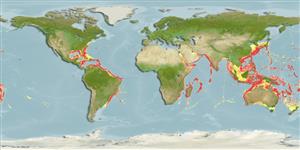Gastropoda |
Pteropoda |
Cavoliniidae
Environment: milieu / climate zone / djupintervall / distribution range
Ekologi
Pelagiska; djupintervall 0 - 1234 m (Ref. 83435). Subtropical
Indo-Pacific and Atlantic Ocean.
Length at first maturity / Size / Weight / Age
Könsmognad: Lm ? range ? - ? cm Max length : 0.7 cm DL hane/ej könsbestämd; (Ref. 83435)
Epipelagic (Ref. 108717). Dead shells frequently washed up on the beaches (Ref. 88739). Members of the family Cavoliniidae use mucus feeding to collect particles from surrounding waters (Ref. 108718). Feeds on plants (Ref. 108717). Suspension feeder (Ref. 109264).
Life cycle and mating behavior
Könsmognad | Reproduktion | Lek | Eggs | Fecundity | Larvae
Members of the order Thecosomata are mostly simultaneous hermaphrodites.
Rottman, M. 1978 Ecology of recurrent groups of pteropods, euphausiids, and chaetognaths in the Gulf og Thailand and the South China Sea. Mar. Biol. 48:63-78. (Ref. 3702)
IUCN Red List Status
(Ref. 130435: Version 2025-1)
CITES status (Ref. 108899)
Not Evaluated
Not Evaluated
Threat to humans
Human uses
| FishSource |
Verktyg
Ytterligare information
Population dynamicsTillväxt
Max. ages / sizes
Length-weight rel.
Length-length rel.
Length-frequencies
Mass conversion
Abundans
PhysiologySyreförbrukning
Human RelatedStamps, coins, misc.
Internet-källor
Estimates based on models
Preferred temperature
(Ref.
115969): 8.1 - 20.3, mean 12.4 (based on 864 cells).
Fishing Vulnerability
Low vulnerability (10 of 100).
Price category
Unknown.
